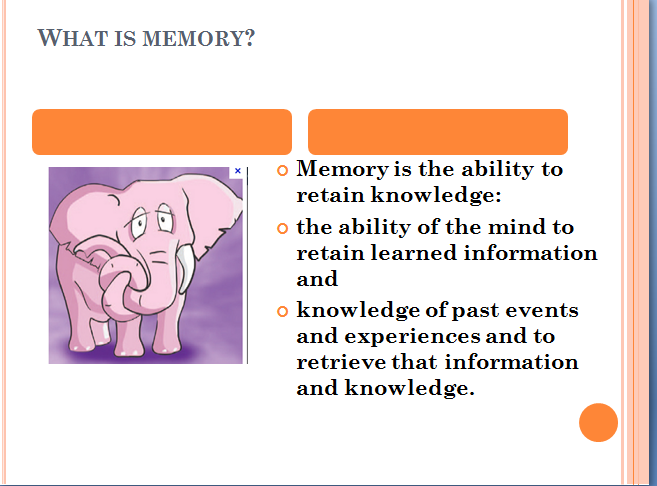Critical Reading for College and Beyond Chapter 3- Remembering What You Read Reflection: This chapter describes what memory is, strategies for remembering long term, recall strategies and test taking and memory skills. Remembering what you read is enormously important in school. If you are simply reading the words without being able to retain the information you will not be a successful student. I find the text incredibly helpful and am putting the tips to use in getting through the chapter and also with my other class. My favorite recommendations are chunking and connecting new information to information you already know. Review: The book explains that consecutive steps are essential for your memory to function. These steps are sensory memory, short term memory and long-term memory. Sensory memory is the first stage of three in the memory process. Sensory memory is described as when you first encounter something. New information enters your brain but it is only retained for a fraction of a second. There is not much storage space in your sensory memory and you will have to purposely transfer this new information to your short term memory. Short-term memory is the second level in the memory process. Information placed here is also impermanent with little capacity. You can move information from sensory to short term. And it can be done purposefully or subconsciously. To move something from your short-term to long term memory you must use additional strategies to transfer it. Long-term memory is the final stage. Things cannot be stored here without first going through the other two levels. You can use the tactics in this book to develop your long term memory. Review question: What is memory? Memory: The ability to retain knowledge: the ability of the mind to retain learned information and knowledge of past events and experiences and to retrieve that information and knowledge. Memory is what enables us to pass a test, remember where we parked and recall our childhood to name a few. It is the process that allows us to acquire, store, retain and later retrieve. If something bad happens to you remembering what it was so it will not happen again will save you from repeating the same mistake. Like the saying fool me once shame on you fool me twice shame on me. Storing experiences in your long term memory can serve as a lesson of what not to do in the future. Every day we are consciously and subconsciously making memories. Weather we are memorizing answers for a test or subconsciously going over every detail in our mothers face these memories will be stored in one of the three memory process levels. Thinking for Yourself Chapter 3-Facts: What’s Real? Reflection: Chapter three discusses learning how to recognize facts, verifying them, that they are not absolutes, distinguishing facts from fiction and building arguments. It asks you to list facts to describe photographs; which is an exercise that challenges your awareness. People use facts to make informed choices. Such as buying a car or which school to go to. I enjoyed the whole chapter in particular the section Distinguishing Facts from Fiction. It used commercials as an example of advertising getting consumers to accept fakery. Review: A fact is something that people will agree corresponds to a reality. One characteristic of facts is that they can be verified. Today the easiest way to verify a fact would be the internet. The need for verifying shows that not all “facts” are true. An example that facts are not absolutes is the theory that the earth was flat. This theory was once accepted to be true but has now been disproven. Distinguishing facts from fiction helps us weed out rubbish. It’s like watching one of the many prescription drug commercials on mute, and simply reading the long list of health warnings at the bottom of the screen. Review Question? How do you decipher between fact and fiction? It can be said that anything that is true is a fact and anything that is fictitious is fiction. The best way to find out if something is true or false would be to verify it. Check your sources and what they are telling you. A gullible person will be easily fooled. However, someone who thinks twice will understand the difference between real and fake. |
Monday, July 9, 2012
Student Homework Example and ePortfolio Slide -- Noelle
Subscribe to:
Post Comments (Atom)

No comments:
Post a Comment